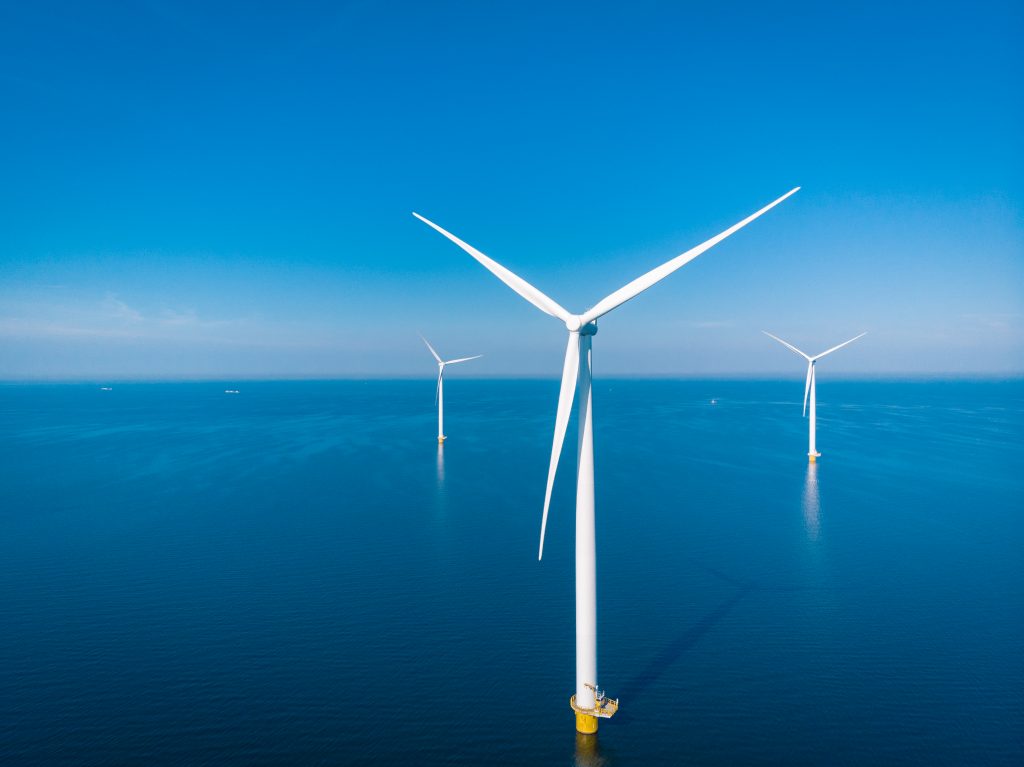
How Europe’s hydrocarbon economies are laying the groundwork for a green hydrogen industry.
Green hydrogen has caught the attention of governments, policymakers, the energy sector and hydrocarbon industry, as way to decarbonise heat and transportation sectors, as well as industries such as steel production.
Hydrogen is a versatile gas, but current production is fossil fuel based. Brown hydrogen comes from gasification (coal or lignite). Grey hydrogen is produced from steam methane reformation (SMR). Blue hydrogen is obtained when pairing SMR with carbon capture and storage (CCS).
Hydrogen can also be made by electrolysis, using electricity to split water into oxygen and hydrogen. When the source of electrons is a wind, solar or biomass plant, the result is green hydrogen.
Green, or renewable, hydrogen can be turned into fuel for transport, or ammonia. It can be injected into existing natural gas networks or stored for months on end – seasonal storage – to be converted back into electricity to feed demand during peak periods, such as especially cold winters. It can even be used to help balance fluctuations in grid frequency.
Drivers for Green Hydrogen.
Recent studies have highlighted the falling cost of wind and solar photovoltaics as critical to reducing the cost of green hydrogen over the next decade and beyond.
In its The Future for Green Hydrogen report, analyst Wood Mackenzie predicts that once renewable electricity reaches $30/MWh (50% load hours), levelised cost of green hydrogen will be at parity with grey hydrogen by 2030 in most markets.
Wood Mackenzie’s report found 253MW of green hydrogen projects have been deployed to date and forecasts this amount to exceed 3205MW of electrolyser installed capacity, globally, by 2025, a 1272% increase.
Path to Hydrogen Competitiveness: A cost perspective, published by the Hydrogen Council (written by McKinsey), forecasts green hydrogen costs will fall by as much as 60% by 2030.
According to the report, once green hydrogen costs around $1.80/kg (£1.40/kg) it could unlock as much as 15% of global energy demand by 2030.
Green hydrogen won’t be competitive in many markets until after 2025, but the projects and pilots happening now will potentially lay the groundwork for the long-talked about ‘hydrogen economy’.
Globally, Europe is leading green hydrogen activity. Many economies, historically active in North Sea oil and gas, such as the Netherlands and the UK, have also been exploiting their offshore wind resources. Green hydrogen can integrate both sectors.
Shell and Co eye mega-offshore wind-hydrogen plant.
Shell, Gasunie and Groningen Seaports have launched a project that could result in the construction of a purpose-built 3-4GW offshore wind farm in the North Sea dedicated to generating electricity for the industrial-scale production of green hydrogen by 2030.
The partners aim to complete a feasibility study for the NortH2 project by the end of 2020
The first offshore wind turbines for the project could be installed by 2027 to produce the first hydrogen that year, according to the consortium.
Green hydrogen production, initially in Eemshaven, is expected to be around 800,000 tonnes per year by 2040. By then year the partners envisage a 10GW offshore wind complex for providing electricity for green hydrogen production. The electrolysers for making hydrogen could also be based offshore.
Gasunie’s natural gas infrastructure will be used to transport green hydrogen to industrial customers in the Netherlands and north-west Europe.
The power-to-gas infrastructure will also act as a “buffer” to provide flexibility in the power grid to balance out variable solar and wind generation.
According to the partners the investments in NortH2 could create thousands of jobs in the northern Netherlands.
Piloting electrolysers at sea.
North Sea Energy (NSE) is a multi-year state-supported project in the Netherlands to prepare for the integration of the country’s offshore wind and natural gas sectors.
The initiative involves establishing demonstrations of green hydrogen production offshore, which hasn’t been done before.
An operational gas platform, owned by Neptune Energy, 12km off the Dutch coast will be installed with a 1MW electrolyser. The pilot, expected to go live by early 2023, will demonstrate the production of green hydrogen at sea, from renewable electricity supplied via a cable that connects the platform to shore and desalinated seawater.
Following the pilot, NSE will commission larger offshore electrolyser plants over the next decade, ultimately connecting these to offshore wind production.
Danish project taps offshore wind turbines to make hydrogen.
In its native Denmark oil and gas player, turned offshore wind developer, Orsted and partners collaborating in a $5.15 million project to construct a 2MW electrolysis plant which also will include hydrogen storage.
In the project, electricity produced from two Siemens Gamesa offshore wind turbines will supply the daily production of 600 kg of green hydrogen, enough to power 20-30 buses.
UK Hornsea 2 offshore wind farm to feed industrial-scale hydrogen plant.
As part of a £30 million funding boost from the UK government, a consortium that includes Orsted recently secured funding to demonstrate green hydrogen at scale.
The £7.5 million second phase of the Gigastack project will see the consortium, led by Sheffield-based electrolyser producer ITM Power, conduct a front-end engineering design (FEED) study on a 100MW electrolyser plant using staged installations with a nominal capacity of 20MW.
The FEED study will detail the actual design of a hydrogen production system, based on ITM Power’s technology, connected to Orsted’s Hornsea 2 offshore wind farm.
Project partner Phillips 66 Limited’s Humber Refinery is the industrial offtaker for the renewable gas.
A key objective of the Gigastack project is to “identify and highlight regulatory, commercial and technical challenges for real applications of industrial-scale renewable hydrogen systems,” the partners stated.
“With industry and government working together, there has been a rapid deployment and a huge cost reduction. This project aims to do the same with hydrogen. At the right cost, this technology has the potential to play a huge role in meeting the UK’s decarbonisation targets,” said Orsted.
Scotland thinks big with green hydrogen.
Based on the Isle of Skye, Highlands & Islands Alba (HIAlba) IDEA is a Scotland-based think tank promoting application of a technology developed by the Australian national science and industrial research agency (CSIRO) to reduce the cost of extracting green hydrogen from ammonia.
According to HIAlba-IDEA, Scotland could generate offshore wind energy in such quantity that it exceeds the UK-based flow of oil and gas from the North Sea, therefore enabling Scotland to become global energy exporter.
The concept lends itself to offshore ammonia production on disused oil rigs servicing offshore wind farms that could be stored in large underwater tanks for periods of low wind to ensure continuous production of renewable electricity.
In a separate initiative Edinburgh-based Eneus is establishing a pipeline of green ammonia production sites, to reduce transmission and distribution costs associated with hydrogen.
The facilities will convert the gas into ammonia, which liquefies at -33°C, compared to hydrogen which forms a liquid at -253°C.
Ammonia is stored and transported using the same technology, logistics and infrastructure as liquified natural gas and can also be used directly to co-fire alongside existing fuels, where pure hydrogen is required.
Scotland’s Orkney island currently hosts an electrolyser provided by ITM-Power as part of the Building Innovative Green Hydrogen systems in an Isolated Territory (BIG HIT) project.
The Orkney Islands have over 50MW of installed wind, wave and tidal capacity. Renewable electricity used to produce the green hydrogen in the project is supplied by wind turbines on the Orkney islands of Shapinsay and Eday. A hydrogen refuelling station, installed as part of BIG HIT, supplies fuel for a fleet of vans on the island each kitted out with a hydrogen fuel cell range extender.
In addition, the gas is also used in two hydrogen-powered boilers at facilities to provide zero carbon heating.
The new hydrogen future.
Many companies traditionally active in offshore oil and gas, from vessels operators, to providers of heavy lifting equipment, to fabricators of offshore structures, not to mention port facilities, have adapted to serve Europe’s offshore wind expansion.
However, for the hydrocarbons industry, which is facing increasing pressure to decarbonise its activities, green hydrogen – as well as blue hydrogen in the interim – ensures the industry continues to be relevant in decarbonised future.
It requires adaptation. According to the Hydrogen Council’s report, industry is prepared to invest, but clarity of policy direction to support hydrogen’s adoption will accelerate progress.
New opportunities for supply chains and job markets that have grown up around offshore oil and gas industries of Europe could span constructing, operating and servicing offshore electrolyser plants to upgrading and maintaining the existing North Sea pipelines and emptied natural gas fields for the storage and transportation of green hydrogen.
Attollo are a key supplier to the offshore Energy industry, if you think we can help get in contact!
Share this insight


